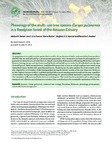Please use this identifier to cite or link to this item:
http://www.alice.cnptia.embrapa.br/alice/handle/doc/1061169Full metadata record
| DC Field | Value | Language |
|---|---|---|
| dc.contributor.author | DANTAS, A. R. | pt_BR |
| dc.contributor.author | LIRA-GUEDES, A. C. | pt_BR |
| dc.contributor.author | MUSTIN, K. | pt_BR |
| dc.contributor.author | APARÍCIO, W. C. S. | pt_BR |
| dc.contributor.author | GUEDES, M. C. | pt_BR |
| dc.date.accessioned | 2017-01-18T11:11:11Z | pt_BR |
| dc.date.available | 2017-01-18T11:11:11Z | pt_BR |
| dc.date.created | 2017-01-18 | pt_BR |
| dc.date.issued | 2016 | pt_BR |
| dc.identifier.citation | Acta Botanica Brasilica, v. 30, n. 4, p. 618-627, Oct./Dec. 2016. | pt_BR |
| dc.identifier.uri | http://www.alice.cnptia.embrapa.br/alice/handle/doc/1061169 | pt_BR |
| dc.description | Carapa guianensis is a multi-use tree species that is used for the production of timber and non-timber forest products (NTFPs) that are used and sold by rural Amazonian populations. Here we aimed to evaluate the phenophases of C. guianensis in várzea forest and relate them to climatic seasonality. Phenophases of fl owering (fl ower buds and open flowers), fruiting (unripe and ripe fruits), and leaf fl ush and leaf fall were recorded for 30 individual trees during a 25 month period. Relationships between rainfall and the proportion of trees in each phenophase were tested using Generalised Linear Models with quasi-binomial errors. Flowering was found to peak in the driest months of the year (September to December), while fruiting peaked during the wettest months of the year when river levels are at their highest (January to May). Leaf fl ush and leaf fall occurred simultaneously throughout the year, regardless of seasonality. Strong seasonality in fl owering and fruiting of C. guianensis likely represents a reproductive strategy that maximizes pollination and hydrochorous seed dispersal. This study has the potential to aid in planning the timing of seed collection and oil extraction activities, thus contributing to the sustainable exploitation of this tree. | pt_BR |
| dc.language.iso | eng | eng |
| dc.rights | openAccess | eng |
| dc.subject | Manejo florestal sustentável | pt_BR |
| dc.subject | Sustainable forest management | pt_BR |
| dc.subject | Agronomic characteristics | pt_BR |
| dc.title | Phenology of the multi-use tree species Carapa guianensis in a floodplain forest of the Amazon Estuary. | pt_BR |
| dc.type | Artigo de periódico | pt_BR |
| dc.date.updated | 2017-01-19T11:11:11Z | pt_BR |
| dc.subject.thesagro | Andiroba | pt_BR |
| dc.subject.thesagro | Ecologia vegetal | pt_BR |
| dc.subject.thesagro | Características agronômicas | pt_BR |
| dc.subject.nalthesaurus | Plant ecology | pt_BR |
| riaa.ainfo.id | 1061169 | pt_BR |
| riaa.ainfo.lastupdate | 2017-01-19 | pt_BR |
| dc.identifier.doi | https://doi.org/10.1590/0102-33062016abb0282 | pt_BR |
| dc.contributor.institution | ADELSON R. DANTAS, INPA | pt_BR |
| dc.contributor.institution | ANA CLAUDIA LIRA-GUEDES, CPAF-AP | eng |
| dc.contributor.institution | KAREN MUSTIN, CPAF-AP | eng |
| dc.contributor.institution | WEGLIANE C. S. APARÍCIO, UNIFAP | eng |
| dc.contributor.institution | MARCELINO CARNEIRO GUEDES, CPAF-AP. | eng |
| Appears in Collections: | Artigo em periódico indexado (CPAF-AP)  | |
Files in This Item:
| File | Description | Size | Format | |
|---|---|---|---|---|
| CPAFAP2016Phenologyofthemultiusetreespeciescarapaguianensis.pdf | 7,65 MB | Adobe PDF |  View/Open |









